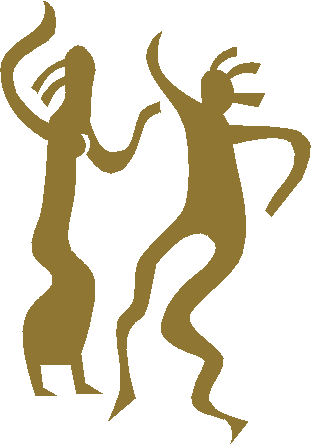You are here: Victoria's
Dance Secrets > ABCs of
Dance > Turns & Pivots
TURNS
& PIVOTS  As you’ve always guessed, there really are
several tricks to graceful and efficient turning. That’s why professional dancers not
only can make multiple turns, they also can keep their balance while turning. As you’ve always guessed, there really are
several tricks to graceful and efficient turning. That’s why professional dancers not
only can make multiple turns, they also can keep their balance while turning.
SPOTTING
The secret to successful balanced and
‘smart’ turns is spotting. All ballet, jazz, folk dancers and other dance
professionals know this technique.
The idea is to focus on one spot, and only
one spot, during the whole turn or series or turns. Let’s try this out.
Choose a
spot on a wall, approximately at your eye level. It could be anything small
enough to concentrate on -- a stain, a nail, a plant leaf, a letter.
Now, stand some 6 to 8 feet
away from the wall and concentrate on your selected spot. Try not to look at anything else
but your spot.
Stand with your feet in
1st position, and put your hands on your hips. Slowly
turn to your right, in 4 counts, until your body faces the opposite wall. As
you do so however, keep your eyes on your spot as long as you can, extending and twisting
your neck and upper body.
As soon as you know that your body
and feet are facing the opposite wall (on counts 4 and 5), swiftly turn your head in the
same direction, without stopping, to look at your spot from your right side. Let your head
and eyes overtake your body’s turn.
Continue to turn your body to
the right in 4 counts, until your whole body faces the original wall.
You
would have made a full turn to the right in 8 counts. And your eyes should have seen
nothing but your spot on the wall. The swiftness of the head’s turn on counts 4 and 5
should have made it impossible for you to see anything else.
The first few times you do this
exercise will make your eye and neck muscles ache a little because the strain, but with
constant practice, you will get used to it.
In the spotting technique, the
eye acts almost like a force point. While it may be the last to leave the spot during the
turn, it should also be the first to reach the same spot even before the body completes
its turn. The eye sets the point where the turn starts and ends; the body follows.
Practice this technique as often
as you can, gradually reducing the time of the full turn. Start with 8 counts,
reduce to 4 counts, then to 2 counts, and finally on 1 count.
By the time you will be doing
turns on two counts, you would also realize that your feet actually step on the 2 counts
too. Many regular turns in ballroom dances are made in 2 counts. Also try to keep your
feet in first position and narrow second position or third
position as you move.
BEST SPOT
In a ballroom hall, the best
‘spot’ or focus point you can use is your partner’s face, because in many
of the dances you start a turn while facing your partner, and have to end facing him
again. What better spot could you look at on a crowded room with moving lights?
CONTROLLED CPB
Control of the center
point of balance is very important during the turns. Make sure your CPB is raised
slightly. This will make you feel lighter and help you ‘soften’ and
‘lighten’ your turn.
FIRM YET LOOSE
HOLD
Even if the Lady partner continues to
practice her turns separately, and can actually control her CPB for the fully balanced
unheld turn, the Man still has to make sure that no accidents will happen.
His role therefore is to signal his
lead for the turn at the right moment, usually on the count before the turn. Make
sure that their hands and fingers are held firmly yet loosely enough.
I have found that a hold which
allows the fingers of either partner to maneuver freely in the hand of the other makes for
a secure and flexible turn. (See section on hand leads.)
The free arm is usually placed
in a position which will not interfere with the turn -- close to the chest or sometimes
down at the back of the hip -- and repositioned immediately as the turn is completed.
Mark Balzer has compiled a series of dancers'
comments and essays on this topic in FAQs on Balance and
Turning. 
|
